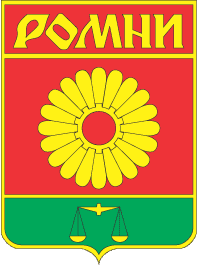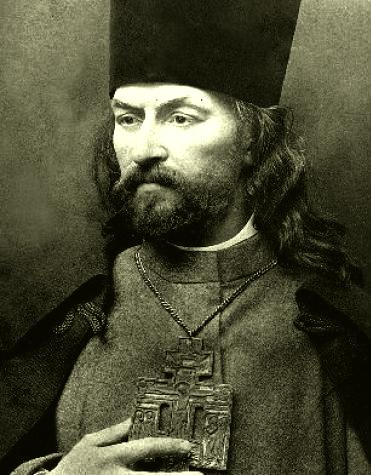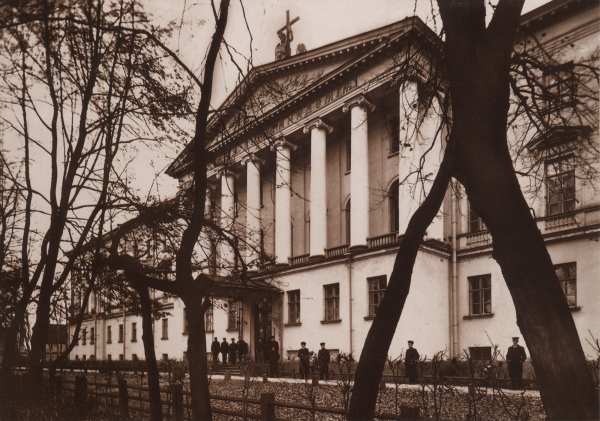|
Pinchas Rutenberg
Pinhas Rutenberg (russian: Пётр Моисеевич Рутенберг, Pyotr Moiseyevich Rutenberg; he, פנחס רוטנברג: 5 February 1879 – 3 January 1942) was a Russian Jewish engineer, businessman, and political activist. He played an active role in two Russian revolutions, in 1905 and 1917. During World War I, he was among the founders of the Jewish Legion and of the American Jewish Congress. Later, he immigrated to Mandatory Palestine, and through his connections managed to obtain a concession for production and distribution of electric power and founded the Palestine Electric Corporation, currently the Israel Electric Corporation. A vocal and committed Zionist, Rutenberg also participated in establishing the Haganah, the main Jewish militia in pre-war Palestine, and founded Palestine Airways. He subsequently served as a President of the Jewish National Council. Socialist and revolutionary Pinhas Rutenberg was born in the town of Romny, north of Poltava, Russia ... [...More Info...] [...Related Items...] OR: [Wikipedia] [Google] [Baidu] |
Romny
Romny ( uk, Ромни́, ) is a city in northern Ukraine, Ukrainian Sumy Oblast. It is located on the Romen (river), Romen River. Romny serves as the administrative centre of Romny Raion. It is administratively incorporated as a City of regional significance (Ukraine), city of oblast significance and does not belong to the raion. The villages of Lutschky (438 inhabitants), Kolisnykove (43 inhabitants) and Hrabyne belong to the Romny Municipality. Population: History The city was founded in AD 902. On September 16, 2002 the city celebrated its 1,100th anniversary. Romny was first mentioned in documents in 1096 (as Romen, ; the name, originally that of the river, is of Baltic origin, cf. Lithuanian language, Lithuanian ''romus'' 'quiet'). At various times, it passed under Mongol Empire, Mongol, Grand Duchy of Lithuania, Lithuanian, Polish–Lithuanian Commonwealth, Polish and Russian Empire, Russian rule. By 1638, the city had a population of 6,000 inhabitants, which made it b ... [...More Info...] [...Related Items...] OR: [Wikipedia] [Google] [Baidu] |
Kibbutz
A kibbutz ( he, קִבּוּץ / , lit. "gathering, clustering"; plural: kibbutzim / ) is an intentional community in Israel that was traditionally based on agriculture. The first kibbutz, established in 1909, was Degania. Today, farming has been partly supplanted by other economic branches, including industrial plants and high-tech enterprises. Kibbutzim began as utopian communities, a combination of socialism and Zionism. In recent decades, some kibbutzim have been privatized and changes have been made in the communal lifestyle. A member of a kibbutz is called a ''kibbutznik'' ( he, קִבּוּצְנִיק / ; plural ''kibbutznikim'' or ''kibbutzniks''). In 2010, there were 270 kibbutzim in Israel with population of 126,000. Their factories and farms account for 9% of Israel's industrial output, worth US$8 billion, and 40% of its agricultural output, worth over US$1.7 billion. Some kibbutzim had also developed substantial high-tech and military industries. For example ... [...More Info...] [...Related Items...] OR: [Wikipedia] [Google] [Baidu] |
Bloody Sunday (1905)
Bloody Sunday or Red Sunday ( rus, Крова́вое воскресе́нье, r=Krovávoe voskresénje, p=krɐˈvavəɪ vəskrʲɪˈsʲenʲjɪ) was the series of events on Sunday, in St Petersburg, Russia, when unarmed demonstrators, led by Father Georgy Gapon, were fired upon by soldiers of the Imperial Guard as they marched towards the Winter Palace to present a petition to Tsar Nicholas II of Russia. Bloody Sunday caused grave consequences for the Tsarist autocracy governing Imperial Russia: the events in St. Petersburg provoked public outrage and a series of massive strikes that spread quickly to the industrial centres of the Russian Empire. The massacre on Bloody Sunday is considered to be the start of the active phase of the Revolution of 1905. In addition to beginning the 1905 Revolution, historians such as Lionel Kochan in his book ''Russia in Revolution 1890–1918'' view the events of Bloody Sunday to be one of the key events which led to the Russian Revolution ... [...More Info...] [...Related Items...] OR: [Wikipedia] [Google] [Baidu] |
Tzar
Tsar ( or ), also spelled ''czar'', ''tzar'', or ''csar'', is a title used by East and South Slavic monarchs. The term is derived from the Latin word ''caesar'', which was intended to mean "emperor" in the European medieval sense of the term—a ruler with the same rank as a Roman emperor, holding it by the approval of another emperor or a supreme ecclesiastical official (the Pope or the Ecumenical Patriarch)—but was usually considered by western Europeans to be equivalent to "king". It lends its name to a system of government, tsarist autocracy or tsarism. "Tsar" and its variants were the official titles of the following states: * Bulgarian Empire (First Bulgarian Empire in 681–1018, Second Bulgarian Empire in 1185–1396), and also used in Tsardom of Bulgaria, in 1908–1946 * Serbian Empire, in 1346–1371 * Tsardom of Russia, in 1547–1721 (replaced in 1721 by ''imperator'' in Russian Empire, but still remaining in use, also officially in relation to several regio ... [...More Info...] [...Related Items...] OR: [Wikipedia] [Google] [Baidu] |
Winter Palace
The Winter Palace ( rus, Зимний дворец, Zimnij dvorets, p=ˈzʲimnʲɪj dvɐˈrʲɛts) is a palace in Saint Petersburg that served as the official residence of the Emperor of all the Russias, Russian Emperor from 1732 to 1917. The palace and its precincts now house the Hermitage Museum. Situated between Palace Embankment and Palace Square, adjacent to the site of Peter the Great's original Winter Palace, the present and fourth Winter Palace was built and altered almost continuously between the late 1730s and 1837, when it was severely damaged by fire and immediately rebuilt. The storming of the palace in 1917, as depicted in Soviet art and in Sergei Eisenstein's 1928 film ''October'', became an iconic symbol of the Russian Revolution. The emperors constructed their palaces on a monumental scale that aimed to reflect the might and power of Russian Empire, Imperial Russia. From the palace, the tsars ruled over (almost 1/6 of the Earth's landmass) and Russian Empire Ce ... [...More Info...] [...Related Items...] OR: [Wikipedia] [Google] [Baidu] |
Adoption Of The Gregorian Calendar
The adoption of the Gregorian Calendar was an event in the early modern history of most cultures and societies, marking a change from their traditional (or "old style") dating system to the modern (or "new style") dating system the Gregorian calendar that is widely used around the world today. Some states adopted the new calendar from 1582, some did not do so before the early twentieth century, and others did so at various dates between. A number of jurisdictions continue to use a different civil calendar. For many the new style calendar is only used for civil purposes and the old style calendar remains used in religious contexts. Today, the Gregorian calendar is the world's most widely used civil calendar. During and for some time after the change between systems, it has been common to use the terms "Old Style" and "New Style" when giving dates, to indicate which calendar was used to reckon them. The Gregorian calendar was decreed in 1582 by the papal bull by Pope Gregory ... [...More Info...] [...Related Items...] OR: [Wikipedia] [Google] [Baidu] |
Okhrana
The Department for Protecting the Public Security and Order (russian: Отделение по охранению общественной безопасности и порядка), usually called Guard Department ( rus, Охранное отделение, tr= okhrannoye otdelenie) and commonly abbreviated in modern English sources as Okhrana ( rus , Охрана, p=ɐˈxranə, a=Ru-охрана.ogg, t= the guard) was a secret-police force of the Russian Empire and part of the police department of the Ministry of Internal Affairs (MVD) in the late 19th century and early 20th century, aided by the Special Corps of Gendarmes. Overview Formed to combat political terrorism and left-wing revolutionary activity, the Okhrana operated offices throughout the Russian Empire, as well as satellite agencies in a number of foreign countries. It concentrated on monitoring the activities of Russian revolutionaries abroad, including in Paris, where the Okhrana agent Pyotr Rachkovsky ... [...More Info...] [...Related Items...] OR: [Wikipedia] [Google] [Baidu] |
George Gapon
Georgy Apollonovich Gapon. ( –) was a Russian Orthodox priest and a popular working-class leader before the 1905 Russian Revolution. After he was discovered to be a police informant, Gapon was murdered by members of the Socialist Revolutionary Party. Father Gapon was mainly remembered for leading a peaceful protest for better freedom and living conditions to which the Imperial Army responded by firing upon the crowd. Early life Georgy Apollonovich Gapon was born , in the village of Beliki, Poltava Oblast, Ukraine, then part of the Russian Empire. He was the oldest son of a Cossack father and mother who hailed from the local peasantry. Gapon's father, Apollon Fedorovich Gapon, had some formal education and served as an elected village elder and clerk in Beliki. His mother was illiterate but religiously devout and actively raised her son in the norms and traditions of the Russian Orthodox Church. Gapon was an excellent primary school student and was offered a place at the L ... [...More Info...] [...Related Items...] OR: [Wikipedia] [Google] [Baidu] |
Working Class
The working class (or labouring class) comprises those engaged in manual-labour occupations or industrial work, who are remunerated via waged or salaried contracts. Working-class occupations (see also " Designation of workers by collar colour") include blue-collar jobs, and most pink-collar jobs. Members of the working class rely exclusively upon earnings from wage labour; thus, according to more inclusive definitions, the category can include almost all of the working population of industrialized economies, as well as those employed in the urban areas (cities, towns, villages) of non-industrialized economies or in the rural workforce. Definitions As with many terms describing social class, ''working class'' is defined and used in many different ways. The most general definition, used by many socialists, is that the working class includes all those who have nothing to sell but their labour. These people used to be referred to as the proletariat, but that term has gone out of ... [...More Info...] [...Related Items...] OR: [Wikipedia] [Google] [Baidu] |
Assembly Of Russian Factory And Plant Workers
Assembly may refer to: Organisations and meetings * Deliberative assembly, a gathering of members who use parliamentary procedure for making decisions * General assembly, an official meeting of the members of an organization or of their representatives * House of Assembly, a name given to the legislature or lower house of a bicameral legislature * National Assembly, either a legislature or the lower house of a bicameral legislature in some countries ** National Assembly (other) * Popular assembly, a localized citizen gathering to address issues of importance to the community * Qahal, or assembly, an Israelite organizational structure * People's Assembly (other) * Assembly of Experts, the deliberative body empowered to designate and dismiss the Supreme Leader of Iran * Freedom of assembly, the individual right to come together and collectively express, promote, pursue and defend common interests * School assembly, a gathering of all or part of a school Science, ... [...More Info...] [...Related Items...] OR: [Wikipedia] [Google] [Baidu] |
Putilov Plant
The Kirov Plant, Kirov Factory or Leningrad Kirov Plant (LKZ) ( rus, Кировский завод, Kirovskiy zavod) is a major Russian mechanical engineering and agricultural machinery manufacturing plant in St. Petersburg, Russia. It was established in 1789, then moved to its present site in 1801 as a foundry for cannonballs. The Kirov Plant is sometimes confused with another Leningrad heavy weapons manufacturer, ''Factory No. 185 (S.M. Kirov)''. Recently the main production of the company is Kirovets heavy tractors. History In 1868 Nikolay Putilov (1820-1880) purchased the bankrupt plant; at the Putilov Works the Putilov Company (a joint-stock holding company from 1873) initially produced rolling stock for railways. The establishment boomed during the Russian industrialization of the 1890s, with the work-force quadrupling in a decade, reaching 12,400 in 1900. The factory traditionally produced goods for the Russian government, with railway products accounting for more than ... [...More Info...] [...Related Items...] OR: [Wikipedia] [Google] [Baidu] |
Socialist-Revolutionary Party
The Socialist Revolutionary Party, or the Party of Socialist-Revolutionaries (the SRs, , or Esers, russian: эсеры, translit=esery, label=none; russian: Партия социалистов-революционеров, ), was a major political party in late Imperial Russia, and both phases of the Russian Revolution and early Soviet Russia. The SRs were agrarian socialists and supporters of a democratic socialist Russian republic. The ideological heirs of the Narodniks, the SRs won a mass following among the Russian peasantry by endorsing the overthrow of the Tsar and the redistribution of land to the peasants. The SRs boycotted the elections to the First Duma following the Revolution of 1905 alongside the Russian Social Democratic Labour Party, but chose to run in the elections to the Second Duma and received the majority of the few seats allotted to the peasantry. Following the 1907 coup, the SRs boycotted all subsequent Dumas until the fall of the Tsar in the February R ... [...More Info...] [...Related Items...] OR: [Wikipedia] [Google] [Baidu] |









